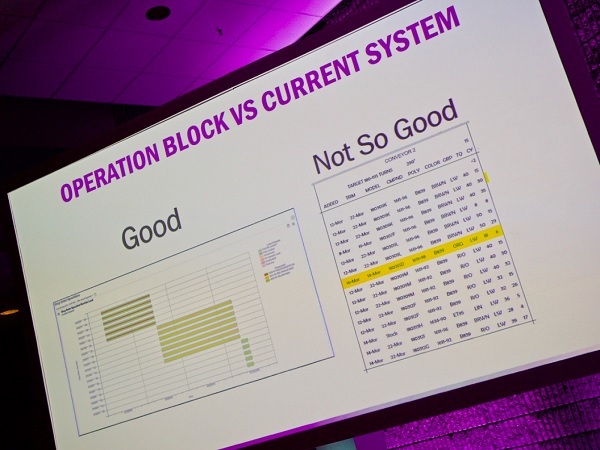Live blog coverage from the IFS World Conference 2018 breakout session, “Learn how HEXPOL benefits with the new solution in IFS Applications 10 for operation block planning and execution.”
Björn Hultgren, Principal Business Systems Analyst, IFS R&D Manufacturing, Sweden introduced us to two important new concepts in IFS Applications 10 for manufacturing:
Resource sharing
Resource share specifies how big a share of the resource capacity an operation will/actually uses during its duration.
For example:
Resources share per unit (for fixed time operations:
- Ovens
- Autoclaves
Fixed resource share
- Printing press
- Assembly area
It affects the cost and load of the operation. It’s defined in a routing operation. It allows detailed management and allocation of resources.

Operation block
So, how do we plan which operations are suitable to be planned together?
An operation block supports the planning, scheduling and reporting of operations to be executed together by a work center resource. These can be in parallel or in sequence. It’s used to create a schedule that maximizes the throughput of a bottleneck resource. There are dynamic columns for configuration and parts characteristics.
For example, this allows parts to be grouped together by the cooer they’re due to be painted, maximizing the throughput of painting operations, by minimizing setup time. Or for making sure that every oven cycle is run with as full an oven as possible.
Case study: Mark Shea, President HEXPOL Stellana US Inc.
Stellana is part of the HEXPOL Wheels Group. They have 45 employees in Lake Geneva, and they produce wheels and tires primarily for the forklift industry. They’ve been using IFS Applications since 2013 and version 7.5.
Currently, they use spreadsheets and their brains to plan production, and up until now, IFS didn’t have the tools to manage the complexity of their constraints. No system did. That’s why they dumped the order info out of IFS Applications and went to work manually. Their work is completely made to order, with 750 to 1,000 discrete order lines per week, with 50-75 Polyurethane Systems and color combinations per week.
Their current system is paper-based on the floor and updated up to five times a day. And the end of the process data is dumped back into IFS Applications – but from the moment they export the jobs out of IFS until the end results are inputted, they have a data back out, often over-night. They hope the new IFS Applications 10 will allow them to have real-time reporting, a streamlined scheduling process and to start using Visualizer. They’re also planning to allow client reporting of production stage.
In their casting operations, they run in parallel and in their trimming operations, they run in sequence. With both methodologies, they use the resource sharing tool in conjunction with the shop floor workbench, this will give then greater fidelity in their costing measurements.
As Shea puts it, their old system was “not good” and the new IFS-based approach is “good.”
That’s a result.

Q&A
- How complex can the characteristics be? You can connect a lot of characteristics – but the limit is 10.
- Where is labor time reported? In the individual operations, distributed in the same way as the cost of the machine is distributed between operations.